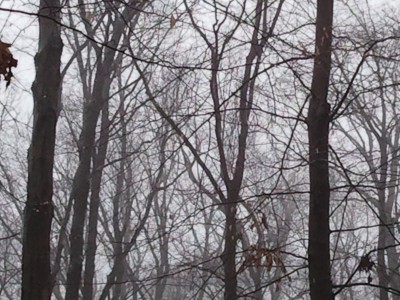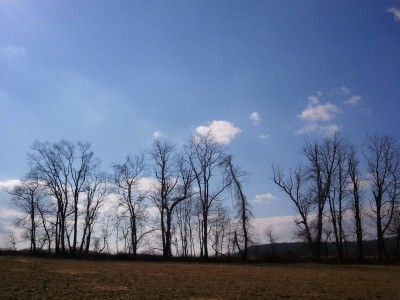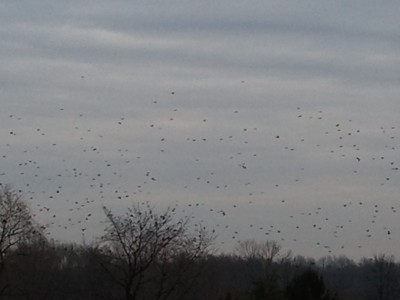 Monday: the mist, shifting, elusive, solemn, seemed to wait on the top of the hill. I could see the sheerest waves of it come past me, and it hovered also in the trees on the ground below me. The mix of all those branches looked like a fish skein placed in a current. Nothing moved in them though. No birds. North of us big trucks hurtled down the mile straightaway on the next ridge, and their tires’ frictioned roar sometimes overwhelmed every other sensation.
Monday: the mist, shifting, elusive, solemn, seemed to wait on the top of the hill. I could see the sheerest waves of it come past me, and it hovered also in the trees on the ground below me. The mix of all those branches looked like a fish skein placed in a current. Nothing moved in them though. No birds. North of us big trucks hurtled down the mile straightaway on the next ridge, and their tires’ frictioned roar sometimes overwhelmed every other sensation.
No deer. The forest was a brown-black color – earth, fallen trees, wet blankets of leaves, dark tree trunks fading three-dimensionally away and becoming blotches in the distance. Close by, the faded gold of beech trees’ dead leaves, their thick trunks a greenish gray. Patches of unbroken snow. Andrew Wyeth had these colors nailed. It grew colder. I could see my breath.
Sleet. When the trucks left off their noise, I could hear it striking the branches all around me. Later, I found a haiku by Basho that summed up the moment:
Winter downpour –
even the monkey
needs a raincoat.
Monkey walks. Monkey wet. This monkey needs a better coat … and a shot of Limoncello.
Slipping down through freezing mud twenty minutes later, the only bird of the walk smoothly plunged straight through the trees as if on a zip line, its white wing bars alternating appear/disappear at great speed — another Pileated woodpecker, a big, startling bird. I have seen them every day for a week now.
 Tuesday: the sun has climbed high in the late morning, and even though the ground is so hard that rocks bounce when dropped onto it, the water is running in rivulets through the woods next to the fields. Moss spread along their banks is a bright green, a color that today seems in accord with the deep blue of the sky. A weather front came through yesterday and blew all the humidity out of the air. I can see details of the landscape on ridge lines several miles in the distance.
Tuesday: the sun has climbed high in the late morning, and even though the ground is so hard that rocks bounce when dropped onto it, the water is running in rivulets through the woods next to the fields. Moss spread along their banks is a bright green, a color that today seems in accord with the deep blue of the sky. A weather front came through yesterday and blew all the humidity out of the air. I can see details of the landscape on ridge lines several miles in the distance.
Walking fast, I surge up hills, across stubble and flat, broken grass, through briary thickets, down paths to denser thickets in lowlands. Juncos lift off the ground ahead of us. Sparrows flick into deeper brush.
Almost no one comes here. In my avaricious heart I sometimes imagine where I would plant our small house – at the rise in the field in the midst of a perpetual rapture of light. In summer we’d have to cover the decks in silken sheets to shelter us from the heat, but the light would continue to shimmer all around us as if it could serve as a hedge against any misfortune
 Wednesday: for more than a minute the grackles and red-winged blackbirds flew above us in an unbroken, sinuous beltway of thousands. Then, erupting from trees where they had been invisible, seven more individual bursts followed, each one composed of hundreds of birds. They flew into the woods to the north, but just a few minutes later they came flowing back making a continuous crackling sound like ice breaking up. They settled in a line of nine tall trees across from our home but collectively never stopped moving. The branches seemed shaped and reshaped by their bodies as if one were watching speeded-up film of trees being buffeted by wind. In Pilgrim at Tinker Creek Annie Dillard called this incarnate flexing Zugunruhe, the pull of migratory restlessness, but this was a northward pull toward a sun riding higher in its zenith with each passing day.
Wednesday: for more than a minute the grackles and red-winged blackbirds flew above us in an unbroken, sinuous beltway of thousands. Then, erupting from trees where they had been invisible, seven more individual bursts followed, each one composed of hundreds of birds. They flew into the woods to the north, but just a few minutes later they came flowing back making a continuous crackling sound like ice breaking up. They settled in a line of nine tall trees across from our home but collectively never stopped moving. The branches seemed shaped and reshaped by their bodies as if one were watching speeded-up film of trees being buffeted by wind. In Pilgrim at Tinker Creek Annie Dillard called this incarnate flexing Zugunruhe, the pull of migratory restlessness, but this was a northward pull toward a sun riding higher in its zenith with each passing day.